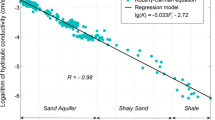Abstract
The properties of a Pleistocene aquifer located in NW Germany were evaluated by means of an inverse two-dimensional numerical model in the vertical plane. The steady-state drawdown recorded at the end of a pumping test was used to calibrate the model with a Gauss-Newton parameter estimation method. The results were analyzed within a formal statistical procedure by means of eigenvalues and eigenvectors. Although a mathematically meaningful value for the standard error can be obtained, the resulting set of permeabilities depends strongly upon the choice of the zonation pattern.
Similar content being viewed by others
References
Bard Y (1974) Nonlinear parameter estimation. New York: Academic Press 341 pp
Busch KF, Luckner L, and Tiemer K (1993) Geohydraulik. Stuttgart: Bornträger-Verlag 497 pp
Carrera J (1988) State of the art of the inverse problem applied to the flow and solute transport equations. In: Custudio E (Ed.), Groundwater Flow and Quality Modelling Dordrecht: Reidel pp 549–583
Carrera J and Neuman SP (1986) Estimation of aquifer parameters under transient and steady state conditions, 1: maximum likelihood method incorporating prior information. Water Resour Res 22(2):199–210
de Wiest RJM (1965) Geohydrology. New York: John Wiley & Sons 366 pp
Hantush MS and Jacob CE (1955) Non-steady radial flow in an infinite leaky aquifer. Am Geophys Union Trans 36:95–100
Haude W (1955) Zur Bestimmung der Verdunstung auf möglichst einfache Weise. Mitt Dtsch Wetterdienst 2(11)
Hofmann U and Hoffmann H (1971) Einführung in die Optimierung. Mit Anwendungsbeispielen aus dem Chemie-Ingenieur-Wesen. Weinheim: Verlag Chemie 264 pp
Lebbe L (1988) Uitvoering van pompproeven en interpretatie door middel van een invers model. Dissertation University of Gent, Belgium
Lebbe L, Mahauden M and De Breuck W (1992) Execution of a triple pumping test and interpretation by an inverse numerical model. Appl Hydrogeol 4:20–34
Renger M and Strebel O (1980) Jährliche Grundwasserneubildung in Abhängigkeit von Bodennutzung und Bodeneigenschaften. Wasser Boden 8:362–366
Segerlind LJ (1984) Applied finite element analysis. New York: John Wiley & Sons 427 pp
Theis CV (1935) The relation between lowering of the piezometric surface and the rate and duration of discharge of a well using groundwater storage. Am Geophys Union Trans 16:519–524
Turc L (1954) Calcul du bilan de l'eau evaluation en fonctien des precipitations et des temperatures. IAHS-Publ. 37:188–202
Wundt W (1953) Gewässerkunde. Berlin: Springer-Verlag 320 pp
Yeh WWG (1986) Review of parameter identification procedures in groundwater hydrology. Water Resour Res 22(2):95–108
Yeh WWG and Yoon YS (1981) Aquifer parameter identification with optimum dimension in parameterization. Water Resour Res 17(3):664–672
Author information
Authors and Affiliations
Rights and permissions
About this article
Cite this article
Aschenbrenner, F., Ostin, A. Automatic parameter estimation applied on a groundwater model: The problem of structure identification. Geo 25, 205–210 (1995). https://doi.org/10.1007/BF00768550
Received:
Accepted:
Issue Date:
DOI: https://doi.org/10.1007/BF00768550




